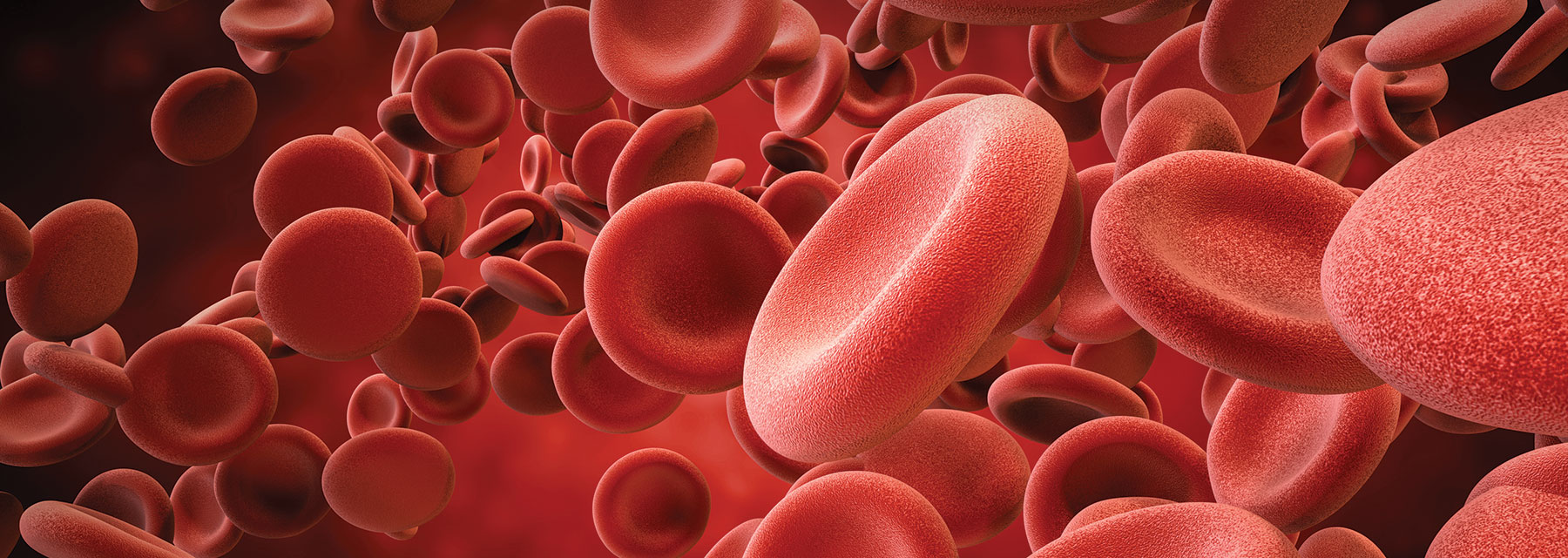Equine Internal Medicine Specialist Dr. Rachel Liepman Shares Her Expertise On Underlying Causes, Considerations For Prevention and How to Address Horses With Equine Anemia
The bond between horse and rider is profound in the equestrian world, where the health and well-being of an equine companion stands paramount. Amid the intricate tapestry of equine care is the specter of anemia. Just like humans, horses grapple with this condition that serves as a beacon signaling an imbalance within the horse's physiological system. It indicates an underlying issue affecting the production, destruction or loss of vital red blood cells (RBCs).
What is Anemia?
Anemia in horses is a decrease in the number of red blood cells or a deficiency in the quality or quantity of hemoglobin, the oxygen-carrying component in the blood.
Red blood cells contain hemoglobin, a complex protein within RBCs that gives blood its red color. It is responsible for transporting oxygen in the blood. Hemoglobin binds to oxygen in the lungs, forming oxyhemoglobin, and releases it to tissue or organs throughout the body, ensuring proper cellular function. Bone marrow, the tissue in the center of bones, is continually producing new RBCs. The rate at which bone marrow produces and releases RBCs is controlled by erythropoietin, a hormone produced in the kidneys. When blood oxygen levels are low, erythropoietin signals for more red blood cells to enter the bloodstream.
Signs of Anemia in Horses
Recognizing the classic signs of anemia is crucial for early intervention. Horses may exhibit subtle changes in behavior that reflect their underlying discomfort. A once energetic and vibrant horse might become lethargic and experience physical fatigue and weakness. This can result in a horse being reluctant to engage in regular activities or exercise. Anemic horses may have an increased respiratory rate, a reflection of the body’s attempt to compensate for decreased oxygen-carrying capacity in the blood. Rapid breathing can indicate the horse’s struggle to maintain adequate oxygen levels. Anemia can impact a horse's appetite, leading to decreased interest in food. Weight loss can also be associated with anemia. One of the key visible signs is the paleness of mucous membranes, including the gums and inner eyelids. A poor hair coat is another sign of the condition.
Signs of Anemia
- Lethargy, fatigue and weakness
- Reluctant to engage in regular activities or exercise
- Increased respiratory rate or frequent yawning
- Decrease in appetite
- Weight loss
- Poor hair coat
- Pale mucous membranes
Unraveling the Symptoms and Seeking the Root Cause
The presence of anemia in horses is concerning, but it is essential to understand that it often serves as a symptom rather than a stand-alone ailment, unless the horse has experienced trauma causing external blood loss. Rachel Liepman, DVM, DACVIM, describes anemia as a “red flag.” To address anemia, it is necessary to explore the underlying conditions contributing to its development. There is a vast array of potential conditions affecting red blood cell production, destruction or loss contributing to anemia. The causes can be broadly categorized into two main types: regenerative and non-regenerative.
Regenerative anemia typically occurs when bone marrow responds to RBC loss by producing new ones. It is often associated with conditions that cause blood loss or cell destruction:
- Hemorrhage (blood loss): Trauma, injury or internal bleeding can lead to blood loss from multiple causes. Gastrointestinal conditions are often a cause of anemia. Dr. Liepman, however, shares that high-grade gastric ulcers are an unlikely cause, while extensive colonic ulcers leading to active bleeding in the intestinal lining, and blood loss, are more likely culprits. Exercise-induced pulmonary hemorrhage can cause blood loss but would have to be profound to cause anemia. Further, internal parasites, such as strongyles, or bloodworms, can damage the intestinal lining, leading to blood loss, especially in young foals that have low blood levels to start with. Coagulation disorders can also increase blood loss, as the clotting ability is compromised. Certain inflammatory diseases can lead to coagulopathies, as well as exposure to rodent poisons. Post-partum mares that have trauma to their large uterine arteries can experience extensive blood loss and horses that get kicked or otherwise severely traumatized can fracture organs leading to internal bleeding.
- Hemolysis (blood cell destruction): This is the result of RBCs being destroyed in the bloodstream or organs, like the spleen or liver, faster than they are produced. It can be the result of various infections or immune-mediated disorders. In equine infectious anemia, the retrovirus causes the immune system to attack RBCs. Blood parasites, like babesia (transmitted by ticks) that cause babesiosis disease, can infect and destroy RBCs. Certain autoimmune disorders can cause the body’s immune system to attack its own healthy RBCs. Neonatal isoerythrolysis in foals is caused by an incompatibility in blood types between mare and foal, causing the mother’s antibodies to attack her offspring’s red blood cells. Mycotoxins and toxins from plants, medications or chemicals can also lead to the destruction of RBCs. Finally, mechanical damage to RBCs can also occur, as seen in exercise-induced hemolysis, found in many disciplines but particularly endurance horses.
Non-regenerative anemia arises when the bone marrow fails to generate enough red blood cells to offset the loss. This type is often associated with:
- Lack of RBC production: Dr. Liepman says, “One of the most common causes of anemia is because of what we refer to as anemia of chronic disease.” Take, for example, chronic inflammation. This condition leads to suppressed erythropoietin production, which impacts RBC production from bone marrow. Older horses often experience this, while also suffering from weakened immune systems, gastrointestinal changes and hormonal fluctuations, such as pituitary pars intermedia dysfunction (PPID) or Cushing's disease, all of which contribute to low-grade anemia. Their slower metabolic rates and reduced exercise levels may also translate to mild anemia in blood tests. Other maladies affecting the production of RBCs are kidney disease and bone marrow disorders. Thoroughbred racehorses are sometimes “doped” with synthetic erythropoietin to boost RBC production. However, this causes the body to halt natural creation of erythropoietin, so a sudden stop in the synthetic hormone can trigger red blood cell levels to drop, leading to a profound anemia.
There are a wide variety of causes of anemia, as illustrated by the above examples. Understanding those is imperative especially to veterinarians in determining an accurate diagnosis and targeted treatment to address the root cause rather than managing symptoms.
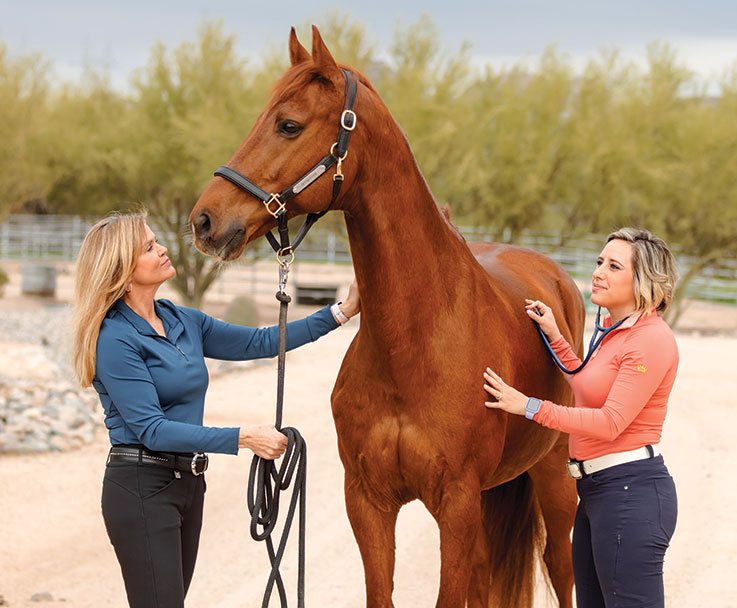
Dr. Rachel Liepman of Cave Creek Equine Sports Medicine and Surgery along with one of her clients.
Dr. Rachel Liepman of Cave Creek Equine Sports Medicine and Surgery along with one of her clients.
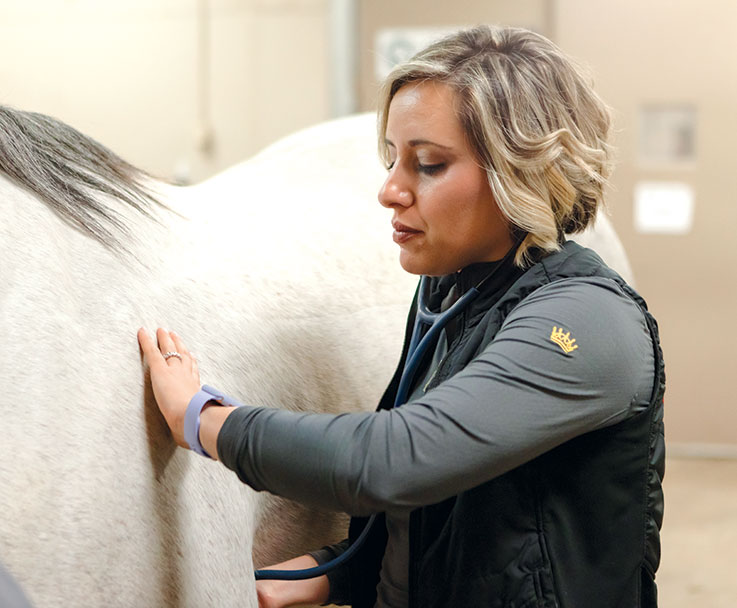
A well-balanced diet is the cornerstone of equine health, and when it comes to preventing anemia, specific nutrients play a pivotal role.
A well-balanced diet is the cornerstone of equine health, and when it comes to preventing anemia, specific nutrients play a pivotal role.
Nourishing Blood Health: Balancing the Diet for Optimal Health
Nutritional deficiencies play a crucial role in the development of anemia. Horses that lack access to good-quality forage, have imbalanced diets or are fed low-quality feeds may not be getting the necessary nutrients for optimal RBC production. A well-balanced diet is the cornerstone of equine health, and when it comes to preventing anemia, specific nutrients play a pivotal role.
Preventing Anemia
- Crafting a Balanced Diet: Nutrient-Rich Feeding Practices
A comprehensive and well-balanced nutrition plan minimizes the risk and impact of anemia. High-quality forage is the foundation of a balanced and nutrient-rich feeding regimen. Supplementing with a comprehensive product like Platinum Performance® Equine can help fill in nutritional gaps, ensuring essential nutrients for optimal health, including those vital for blood nourishment and protection. Also essential is regular reassessment of the diet considering variables such as age, weight, activity level, geographic location and health changes. - Regular Veterinary Checkups
Observe horses for any changes in behavior, weight or physical appearance. Early intervention can prevent the progression of conditions leading to anemia. Schedule routine veterinary checkups to monitor the horse’s overall health. Regular blood tests can help identify early signs of underlying conditions that may lead to anemia. Adhering to a proper vaccination schedule protects horses from infectious diseases that could lead to anemia. A strong immune system is a key component of preventing various health issues. Regular dental work is essential to ensuring the digestion of nutrients is unhindered. - Parasite Control
Implement a robust parasite control program. Follow a strategic deworming schedule based on fecal egg counts and veterinarian recommendations to prevent internal parasites. - Age-Specific Care and Proactive Management of Chronic Conditions
Provide specialized care for older horses that considers increased susceptibility to chronic inflammation, weakened immune systems and hormonal changes. Tailoring regular exercise to their abilities can help maintain a healthy metabolic rate. Age-related anemia necessitates this approach to address the specific needs of senior equines. If a horse has a pre-existing chronic condition, such as pituitary pars intermedia dysfunction (PPID) or Cushing’s disease, work closely with a veterinarian to proactively manage the condition. - Environmental Management
Maintain an environment conducive to the horse’s overall well-being. Ensure stables are clean and well-ventilated, avoid overcrowding. Take precautions against toxins. Get familiar with potential environmental toxins and hazards and proactively address them to safeguard the horse’s health. Store feed in cool, dry conditions and regularly inspect for signs of mold to avoid mycotoxins.
Architects of Red Blood Cells: Iron, Copper, B Vitamins and Protein
Iron
Iron is a fundamental trace mineral essential for the synthesis of hemoglobin. Horses, like their riders, require an adequate intake of iron to support the production of healthy RBCs. However, a true iron deficiency is rare in horses thanks to the natural abundance of iron in their forage-based diets. Balancing the level of dietary iron is crucial to overall equine health. Excessive iron intake, often caused by over-supplementation, can interfere with the absorption of other minerals, making it a cause of a nutrient deficiency. When taken to extremes, iron can become toxic. “I don’t think iron supplementation is always benign,” Dr. Liepman says. Oxidative stress is a significant worry, as iron in fact can act as a free radical leading to cell damage. Elevated levels have been associated with inflammation, oxidative stress, metabolic disorders and liver issues. Further, Dr. Liepman explains that the body’s response to infection is to sequester iron so pathogens cannot use it. As a result, the pathogen’s ability to spread is hindered and the horse’s iron level appears low. In this case, supplementing iron would be counterproductive to the horse’s overall health. According to Dr. Liepman iron supplementation is rarely needed. If a deficiency is suspected, a ferritin test can be performed to determine the horse’s true iron status. Ferritin is a blood protein that stores iron, and, when ferritin is low, so is a horse’s iron stores. Measuring a horse’s iron serum levels in the blood alone is insufficient as most iron in the body is stored.
Copper
Copper, another essential trace mineral, plays a vital role in various enzymatic reactions, including those related to iron absorption and RBC production. A deficiency can impair the mobilization of stored iron, leading to reduced RBC formation. Ensuring adequate copper intake is an important defense against anemia, but maintaining a balanced iron, copper and zinc ratio of 4:1:4 in the total diet is equally important to avoid deficiencies, as these minerals compete for absorption. Copper with zinc can also support RBCs against oxidative stress by bolstering the activity of the enzyme superoxide dismutase, an antioxidant.
B Vitamins
B vitamins, including B6, B9 and B12, play a fundamental role in DNA synthesis and the formation of healthy RBCs. A deficiency in these essential vitamins can contribute to anemia. While mature horses typically synthesize B vitamins in their hindgut microflora, conditions like hindgut acidosis, illness, stress or antibiotic use can disrupt this natural production. Given the water-soluble nature of B vitamins, over-supplementation is less likely. Cobalt, a trace mineral integral to vitamin B12 synthesis, is also important, as it is the only B vitamin not provided through forage.
Protein
Proteins, composed of amino acids, are essential for the synthesis of hemoglobin and RBCs. Horses that have trouble producing RBCs may be receiving insufficient protein or lacking certain essential amino acids, necessary molecules that the horse can only obtain from their diet. Most healthy horses meet their protein needs through quality hay alone and a protein deficiency is uncommon.
Vitamin E and Selenium: Guardians of Red Blood Cells
Vitamin E
Vitamin E is a potent antioxidant, protecting red blood cell membranes from oxidative stress. A deficiency in this nutrient can result in increased cell breakdown to RBCs, potentially contributing to anemia. Vitamin E is essential for maintaining the health of red blood cells and protecting cell membranes from oxidative damage. Horses require a consistent intake of vitamin E to support their antioxidant defenses and overall immune function. Dr. Liepman notes that she is a big proponent of giving high-quality natural vitamin E, in the form of d-alpha-tocopherol acetate, to most clients’ performance horses.
Selenium
Selenium is a trace mineral that plays an important role in the function of antioxidant enzymes, supporting the horse’s immune system and protecting RBCs. Careful consideration must be given to prevent deficiency and toxicity, as too little or too much can lead to health issues. Routine assessment of selenium levels in forage is a valuable guide for judicious dietary supplementation.
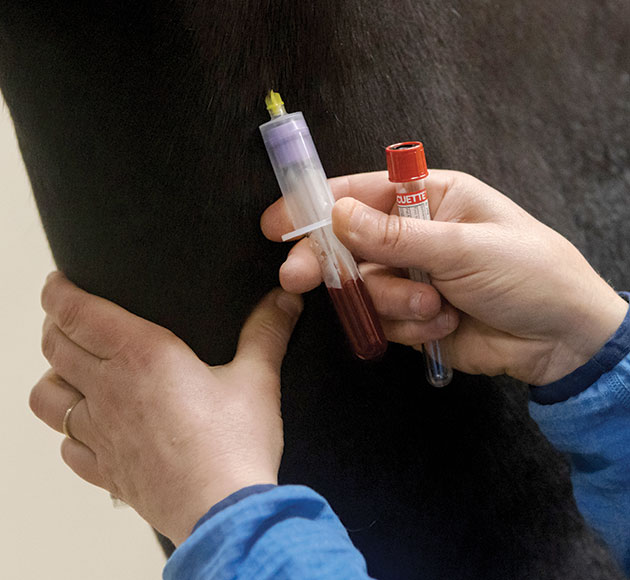
The CBC (complete blood count) provides valuable information about RBC count, hemoglobin levels and packed cell volume (PCV).
The ABCs of Blood Testing
- Packed cell volume (PCV), also known as hematocrit, measures the concentration of red blood cells in blood. This value is often used to determine the severity of the anemia. A PCV of less than 30% indicates a horse is anemic, while anything less than 13% is very severe. Physical appearance may be deceiving. Dr. Liepman underscores the need for blood testing to diagnose anemia, noting that relying solely on a horse’s appearance and behavioral changes may not provide a full picture. For instance, a horse experiencing chronic blood loss resulting in a notably low PCV may not exhibit severe outward symptoms, owing to the body’s capacity to adapt. Conversely, a horse facing acute blood loss, such as internal or external hemorrhage, is more likely to display clear signs of their condition.
- Red blood cell (RBC) count measures the number of circulating red cells in a given volume of blood. A decrease in this count is another indicator of anemia.
- The concentration of hemoglobin, the oxygen-carrying protein, can also be assessed by a complete blood count (CBC). Low hemoglobin levels indicate anemia. When the hemoglobin concentration is 10 or above, a horse is not considered anemic.
- MCV and MCHC: Red blood cell indices measure the size, shape and quality of red cells. These include mean corpuscular volume (MCV), which looks at cell size and volume, and mean corpuscular hemoglobin concentration (MCHC) that measures the amount of hemoglobin relative to the size of the cell provide additional information to further diagnose the cause of anemia.
- Total plasma protein concentration (TP) supplements the diagnostic process, providing a big-picture look into different proteins present in the blood. It offers insight into potential underlying causes, such as blood loss into a cavity or chronic inflammatory infections. Dr. Liepman explains that if a horse has lost blood either externally or into a body cavity, the horse is going to lose protein and red blood cells. If it has a hemolytic problem — where red blood cells are destroyed faster than they can be made — PCV levels would change but the TP would remain the same. The TP can also be high with a low PCV when there is a chronic infection. This is because fibrinogen (a protein involved in clot formation) and globulins (proteins involved in the immune response), are high as a result of chronic inflammation.
Navigating the Path to Understanding
Diagnosing anemia in horses is a multifaceted process using clinical evaluation, specialized tests and a keen understanding of the horse’s overall health. Anemia can be a symptom of various underlying conditions, so a systematic approach is essential to accurately discerning the root cause.
The process often begins with a thorough clinical examination by a veterinarian. This includes assessing the horse’s overall appearance, behavior and noticeable changes. Dr Liepman stresses that gathering a detailed medical history is paramount. Information about recent illnesses, changes in diet and exposure to parasites aids in narrowing the possible causes. A comprehensive examination involves evaluating vital signs, such as heart rate, respiratory rate and temperature. Mucous membrane color is assessed, with paleness indicating a potential reduction in red blood cells.
Blood tests also play a central role. The CBC (complete blood count) provides valuable information about RBC count, hemoglobin levels and packed cell volume (PCV). It’s crucial that the results are interpreted judiciously, considering individual variations and factors such as age, gender, breed and activity level. Racehorses, for instance, may have higher RBC levels due to training practices, impacting the interpretation of anemia markers. Dr. Liepman concurs stating, “Horses in rigorous training are going to have a higher red cell mass than the average horse. I expect a racehorse in training’s PCV to be in the 40s,” which means 40% of the blood is made up of red blood cells. The PCV figure can vary from as low as 31% up to 50% for a “normal” adult horse. Additionally, the timing of blood tests needs consideration. Recent physical exertion or stress can cause a spike in circulating RBCs due to splenic contraction. The equine spleen is quite large, serving as a reservoir, allowing for a rapid release of RBCs when more oxygen is needed because of increased activity.
The Next Step
Beyond a clinical exam and bloodwork, Dr. Liepman explains that the diagnostic process pivots further toward identifying underlying causes. “It’s generally more important to figure out what the underlying problem is and fix that problem. Do that, and the anemia goes away.” Depending on the initial findings, Dr. Liepman says, “We use different techniques to locate the source.” Diagnosing the cause of the anemia can be fairly easy or an extensive process.
Nourishing Blood Health: Platinum Formulas That Can Help
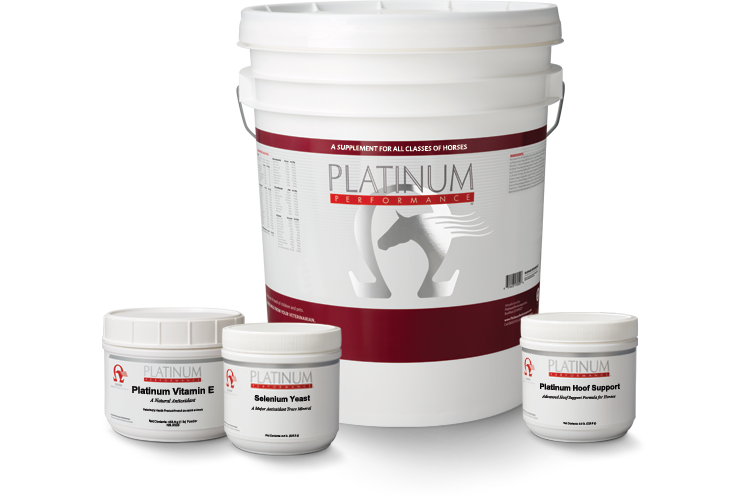
- Platinum Performance® Equine
A comprehensive formula for total body health containing omega-3 fatty acids, amino acids, antioxidants, vitamins and trace minerals. - Platinum Hoof Support
A concentrated source of trace minerals zinc, copper and cobalt, and includes essential amino acids L-lysine and methionine as well as Biotin (B7), a B vitamin. - Platinum Vitamin E
Provides a highly bioavailable form of natural vitamin E, in the form of d-alpha-tocopherol acetate, ensuring maximum absorption and effectiveness. - Selenium Yeast
Provides a bioavailable form of selenium, ensuring enhanced absorption.
Did You Know?
- There is no added iron to Platinum Performance® Equine.
- The concentration of iron in Platinum’s foundation formulas is derived from the natural ingredients inherent in the product, as iron naturally binds itself to other minerals. Because iron is naturally occurring and bound it has little impact on iron levels in a horse’s diet.
- Check the ingredient list for insight into the addition of iron in a given formulation. The ingredient label of Platinum’s foundation formulas shows no added iron in its various forms.
Tailored Treatment Plans
Recognizing anemia as a symptom leads veterinarians to tailoring effective treatment plans that address the underlying cause, Dr. Liepman stresses. This approach enhances the efficacy of interventions, leading to more successful outcomes. Depending on the case, strategies include judicious fluid therapy, interventions to promote clotting, actively halting bleeding, oxygen therapy and providing supportive care, she says.
Dr. Liepman notes that while blood products are not often required in chronic cases, they are frequently employed in acute or sudden situations. In cases of acute internal bleeding, approximately 75% of the lost blood may be reabsorbed by the horse’s body. Additionally, she highlights the remarkable capacity of equine bone marrow to respond within about 72 hours following an insult, or injury, by initiating RBC production. At two to four weeks post-insult, she says, a horse’s PCV may reach around 30%, contingent upon the extent of blood loss. Despite the urgency often associated with anemia, “most of the time anemia is not an emergency unless they have an active bleed from an artery or major vessel,” Dr. Liepman emphasizes, “but it is something that needs to be investigated.” Maintaining open and regular communication with the veterinarian ensures that appropriate treatment plans are in place and followed through effectively.
“Hemoglobin Harmony” in Equine Health
As we learn more about the intricacies of anemia, one thing is certain: it provides a window into the broader landscape of equine health, offering clues to unveil other underlying health issues that require attention and care. Armed with this knowledge, it is important for horse owners to prevent anemia through proper nutrition, preventive vaccinations, deworming and environmental management but also to work closely with the guidance and expertise of veterinarians. Together, comprehensive preventive and treatment strategies address not just the symptoms of anemia but the root causes. In doing so, we safeguard “Hemoglobin Harmony” in our horses. In the realm of equine vitality, “Hemoglobin Harmony” is not just a concept, it’s a commitment. As stewards of these majestic creatures, it is our collective responsibility to embrace that commitment. A commitment to providing a proactive approach to horse care that significantly reduces the risk of anemia and other health issues, preserving the enduring partnership that we share with our beloved equine companions.
Beware of Nature’s Hidden Hazards
Consumption of These Plants Can Cause Equine Anemia:
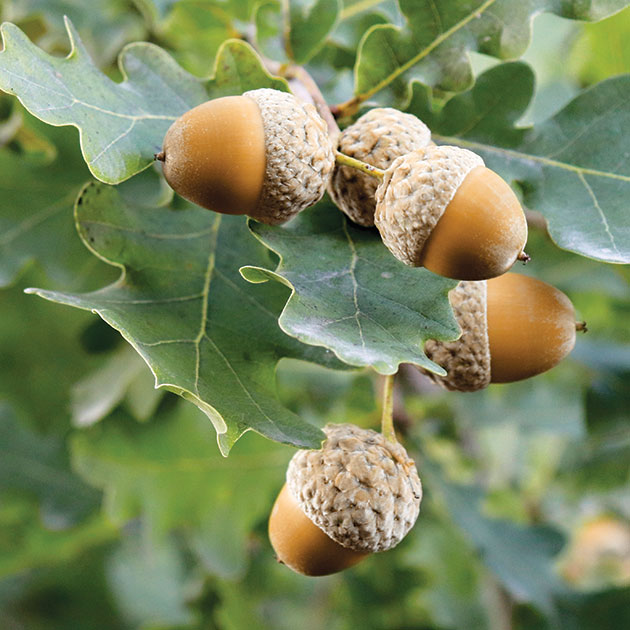
Tannins in leaves, bark and acorns can lead to kidney failure and anemia.
Beware of Nature’s Hidden Hazards
Consumption of These Plants Can Cause Equine Anemia:
- Red Maple Leaves
While the vibrant red hues of red maple leaves are picturesque, toxins in the leaves also pose a significant threat to horses. Ingesting the leaves can lead to a condition known as Red Maple Leaf Poisoning, damaging red blood cells (RBCs), and preventing them from being able to carry oxygen, and potentially resulting in anemia. Be vigilant during fall, especially if horses have access to areas with red maple trees. Regularly inspect pastures and promptly remove any fallen leaves. - Garlic and Onions
Garlic and onion types, common in human cuisine, contain substances that can trigger Heinz body anemia in horses. This condition occurs when the chemical n-propyl disulfide interferes with RBC function, leading to the formation of Heinz bodies — tiny dots (particles of damaged hemoglobin) visible in red blood cells under a microscope. Avoid feeding garlic to horses as no clear associated benefits have been found. - Oak Leaf and Acorns
These can harm horses if ingested in large quantities. Tannins in leaves, bark and acorns can lead to kidney failure and anemia. Clear young fallen oak leaves in the spring and acorns in autumn from grazing areas.
